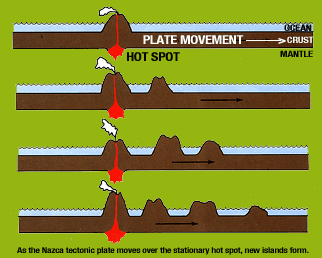TECTONIC PLATES
The Galapagos Islands are volcanic oceanic islands like Hawaii.
The main theory about the origin of the Galapagos archipelago is that they are formed above a ‘hot-spot’ where the mantle is hotter than at other places. We now understand that the surface of the earth is divided into immense tectonic plates, which gradually drift across the globe. The Galapagos Islands are at the meeting of four tectonic plates – the Cocos, the Pacific, the Antarctic, and the Nazca plates.
The Nazca plate is at present drifting south, away from the Cocos plate, and east, away from the Pacific plate. Because of this movement, the Nazca plate is colliding with the South American plate, which is made of light continental crust, riding up over the Nazca plate, which is made of dense oceanic crust. This type of plate interaction is called subduction
As there is a hot spot there, far below the Pacific Ocean, the mantle and the crust in that area heat up until it melts. Molten Lava escapes from the earths core and slowly builds up underwater until it forms undersea mountains, the tops of which gradually grow out of the water creating an island.
The tectonic plates, which are still moving, push the island above slowly eastwards, leaving another piece of the earths crust above the hot spot, which remains stationary. The process is begun again and over millions of years more islands are created forming the archipelago, the islands furthest away from the hot spot are the oldest, and the closest one is still growing.
 |